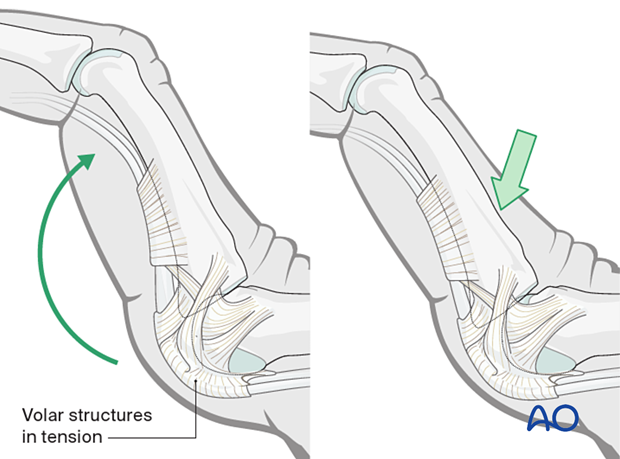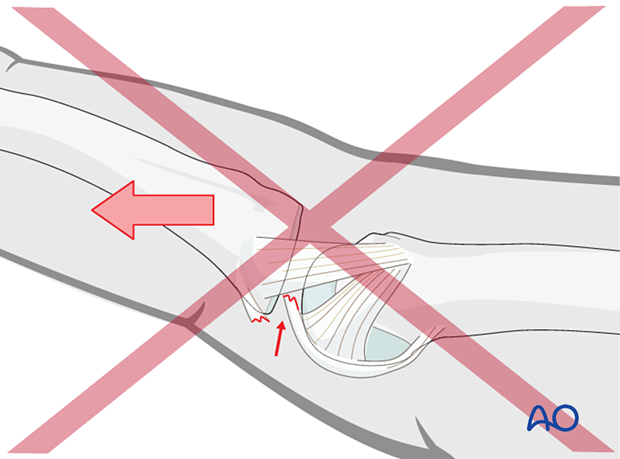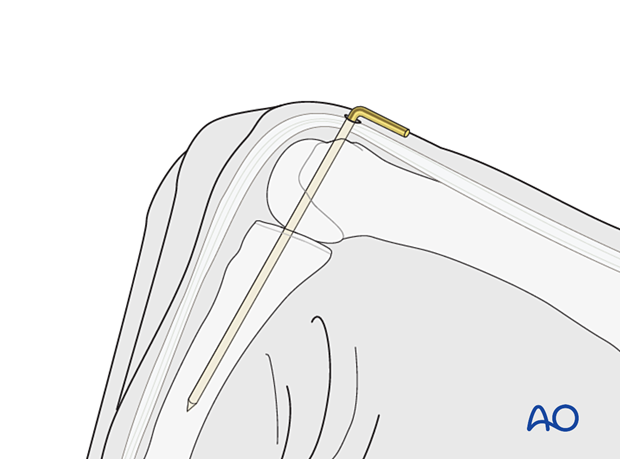ORIF
1. General considerations
Fracture-dislocations of the metacarpophalangeal (MCP) joint may involve articular fractures and avulsion of the metacarpal head which require, after reduction of the dislocation, a separate reduction and fixation.
The metacarpal head fractures are fixed according to their fracture pattern.
If there is persistent joint instability, the joint may be transfixed with a temporary K-wire. In noncompliant patients, transfixation is recommended.

2. Patient preparation
Place the patient supine with the arm on a radiolucent hand table.

3. Approaches
A dorsal approach to the affected MCP joints may be used.
Alternatively, the approach(es) for reduction and fixation of the metacarpal head fracture can be used.
Protect the dorsal sensory nerve branches (radial and ulnar).

4. Reduction of dislocation
Closed reduction
Dislocation usually occurs as an extension deformity.

This can be reduced by increasing the deformity with some dorsally applied pressure on the proximal phalanges to reduce the joint. This keeps the volar structures in tension and reduced the risk of soft-tissue interposition.


5. Reduction and fixation of fractures
Reduce and fix the fractures similar to isolated fractures.
Avulsions:
Partial articular fractures:
Complete articular fractures:

6. Stability evaluation
Confirm reduction and fixation with an image intensifier and check the joint stability by active flexion and extension. This should show congruent movement compared with the adjacent joints.
7. Ligament repair
If there is insufficient MCP joint stability, ligament repair of the volar plate or sagittal band and the extensor mechanism may be required.

8. Joint transfixation with temporary K-wire
If there is persistent instability, transfix the joint temporarily with a K-wire. Flex the MCP joint to 90° and insert the K-wire in an antegrade fashion through the head of the metacarpal into the medullary canal of the proximal phalanx.
Bend the end of the K-wire above the skin and cut it with enough length to avoid migration.

9. Buddy strapping
If the joint is stable, buddy strapping only may be considered.
Strap the injured finger to a neighboring finger.
The strapping should leave the joints free for mobilization.
Direct skin contact with adjacent fingers should be prevented by placing gauze pads between them.

10. Application of a dorsal splint
The hand is supported with a dorsal splint for at least 3 weeks. This would allow for finger movement and help with pain and edema control.
The hand should be splinted in an intrinsic plus (Edinburgh) position:
- Neutral wrist position or up to 15° extension
- Metacarpophalangeal (MCP) joint in 90° flexion
- Proximal interphalangeal (PIP) joint in extension

The reason for splinting the MCP joint in flexion is to maintain its collateral ligament at maximal length, avoiding scar contraction.
PIP joint extension in this position also maintains the length of the volar plate.

11. Aftercare
Postoperative phases
The aftercare can be divided into four phases of healing:
- Inflammatory phase (week 1–3)
- Early repair phase (week 4–6)
- Late repair and early tissue remodeling phase (week 7–12)
- Remodeling and reintegration phase (week 13 onwards)
Full details on each phase can be found here.
Follow-up
X-ray checks of joint position have to be performed immediately after the splint has been applied.
Follow-up x-rays with the splint should be taken after 1 week, and possibly every 2 weeks.
The K-wire can be removed 2 weeks after surgery.
Splinting is continued until about 4 weeks after the injury. At that time, an x-ray without the splint is taken to confirm healing and range of motion should be pain-free.
Mobilization
Splinting can then usually be discontinued, and active mobilization is initiated. Functional exercises are recommended.

Implant removal
The implants may need to be removed in cases of soft-tissue irritation.
In case of joint stiffness or tendon adhesion restricting finger movement, arthrolysis or tenolysis may become necessary. In these circumstances, the implants can be removed at the same time.













